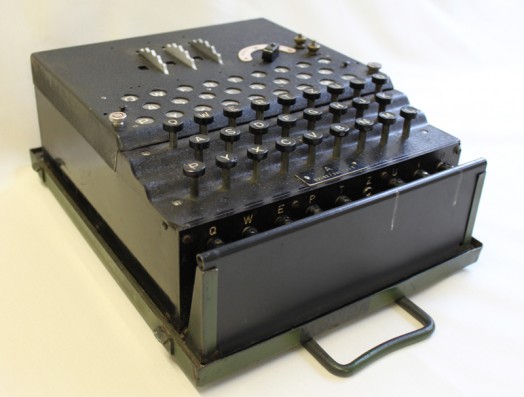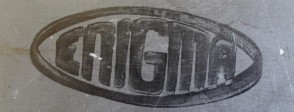
Enigma
This Enigma machine is one of thousands manufactured in Germany by Ertel-Werk manufacturers. The machine was invented in 1918 to protect communications in the banking industry. Because it was battery powered and therefore portable, it was taken up and developed by the German armed forces. This model was produced for use in Luftwaffe ground stations; its metal case - earlier machines had wooden cases - provided extra protection during field operations. Axis officials and forces used Enigma machines to protect their top-secret radio communications throughout World War II. These communications, transmitted in Morse code by wireless radio, were easy to intercept, but their encipherment using Enigma machines, made them incomprehensible to the Allies. This allowed the Luftwaffe to make sudden and devastating attacks and the Kriesgmarine to inflict massive losses on shipping.
How Enigma worked
Enigma represented a new form of encryption using machines rather than hand ciphers or codebooks. It was capable of generating 159 million million million combinations of cipher using an electro-mechanical cipher machine. Messages typed into the machine were scrambled first by movable mechanical rotors inscribed with letters, and then by a plug board of electrical circuits, generating enciphered text. Ciphering depended on the start position of the rotors, which could be removed, rotated and replaced in any order. The text the machine produced was unintelligible unless the receiver knew the rotor and plug board settings on the day the enciphered text was produced. As knowing the machine’s settings was the key to decoding the messages, the Germans reset their Enigma machines at midnight every night to maintain security. Each network used different settings, and slightly different machines. Every month, German Enigma machine operators were issued with a key sheet printed with the daily settings for their network. Soluble ink was used so that the settings could be erased with water if there was a risk of sheets being captured by the Allies.
How Enigma was broken
Thanks to Polish intelligence, the British knew how the Enigma machine worked, but in order to break the code they needed to break the key - the settings that were changed by the Germans daily. The team of British and Polish mathematicians and cryptanalysts who worked to intercept and decode German communications was based at the British Government Code and Cipher School at Bletchley Park and the project focused on the Enigma ciphers became known as the Ultra programme. As breakthroughs were made, additional staff were brought in to support the code breakers and systems were set up to organise this work force as they intercepted, decrypted and processed German communications. Through the course of the war thousands of people worked at Bletchley Park, two thirds of whom were women, some recruited via universities and many drafted in from the services such as the Women’s Royal Naval Service.
In order to discover the daily Enigma settings used by the Germans, British mathematicians Alan Turing and Gordon Welchman developed a device called the Bombe, improving on a Polish invention (the ‘bomba’). This electro-mechanical machine helped to deduce the day’s enigma settings by rapidly eliminating many incorrect variables until the right combination of settings was found. The prototype, named ‘Victory’, was installed at Bletchley Park in March 1940, and began deciphering Luftwaffe communications. Over the course of the war several hundred bombes were produced.
The impact of the Bletchley Park code breakers
By 1944 a new machine named Colossus had been installed at Bletchley Park. It was built by a Post Office engineer named Tommy Flowers in order to decipher communications between Hitler and German High Command which were encrypted using a cipher even more complex than Enigma. Colossus could process information very rapidly and was the world’s first digital electronic computer.
The Bombe and Colossus machines increased the speed at which messages could be decoded and intelligence reports passed to British commanders in the field. Ultra intelligence gave Britain a tactical advantage in the Battle of the Atlantic, for example, and provided information for the planning of the D-Day landings. Sir Harry Hinsley, official historian of British intelligence in World War II, is quoted: “Ultra shortened the war by not less than two years and probably by four years; moreover, in the absence of Ultra, it is uncertain how the war would have ended.”
However, as well as having a direct impact on the conduct of the war, the expertise the code breakers developed and the machines they built to solve the problem of rapidly deciphering messages led to the development of modern computers. Turing, Welchman and others who worked at Bletchley Park went on to continue research and development in computing and artificial intelligence in universities and other scientific institutions. The code breaking processes enabled by machines such as the Bombe and Colossus heralded the beginning of the information age and Bletchley Park is widely regarded as the birthplace of the modern computer.
More information
History of Bletchley Park
http://www.bletchleypark.org.uk/content/hist/
Bletchley Park: Home of the Codebreakers
An online exhibition by the Bletchley Park Trust.
https://www.google.com/culturalinstitute/exhibit/bletchley-park-home-of-the-codebreakers/wRANFg9s
The women of Bletchley Park
An online exhibition by the Bletchley Park Trust.
https://www.google.com/culturalinstitute/exhibit/the-women-of-bletchley-park/QQZ2YSRa?projectId=women-in-culture&position=0%2C-1
The inner workings of an Enigma Machine
A 15 minute video from the Perimeter Institute for Theoretical Physics.
https://www.youtube.com/watch?v=mcX7iO_XCFA
Wartime Bletchley Park
http://www.codesandciphers.co.uk/virtualbp/wartmbp.htm#1938
Colossus
http://www.tnmoc.org/explore/colossus-gallery
Codes and ciphers
Codes and ciphers teaching resources website has teaching resources produced by the centre for Innovation in Mathematics Teaching and Bletchley Park. Aimed at Key Stage 4, these resources explain the mathematics behind Enigma for teachers and students.
http://www.cimt.plymouth.ac.uk/resources/codes/
More information
-
History of Bletchley Park
Source: bletchleypark.org.uk
-
Bletchley Park: Home of the Codebreakers
An online exhibition by the Bletchley Park Trust.
Source: google.com
-
The women of Bletchley Park
An online exhibition by the Bletchley Park Trust.
Source: google.com
-
The inner workings of an Enigma Machine
A 15 minute video from the Perimeter Institute for Theoretical Physics.
Source: youtube.com
-
Wartime Bletchley Park
Source: codesandciphers.co.uk
-
Colossus
Source: tnmoc.org
-
Codes and ciphers
Codes and ciphers teaching resources website has teaching resources produced by the centre for Innovation in Mathematics Teaching and Bletchley Park. Aimed at Key Stage 4, these resources explain the mathematics behind Enigma for teachers and students.
Source: plymouth.ac.uk


